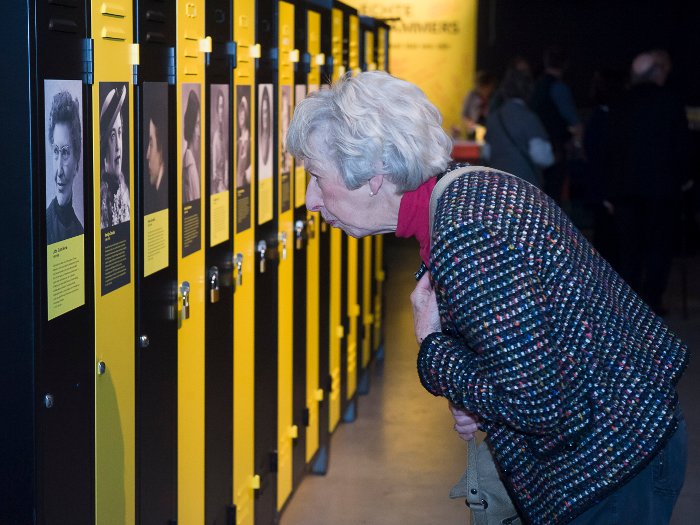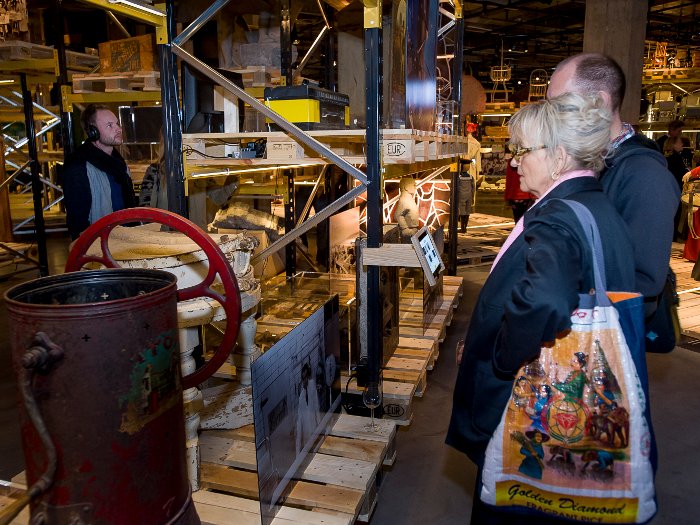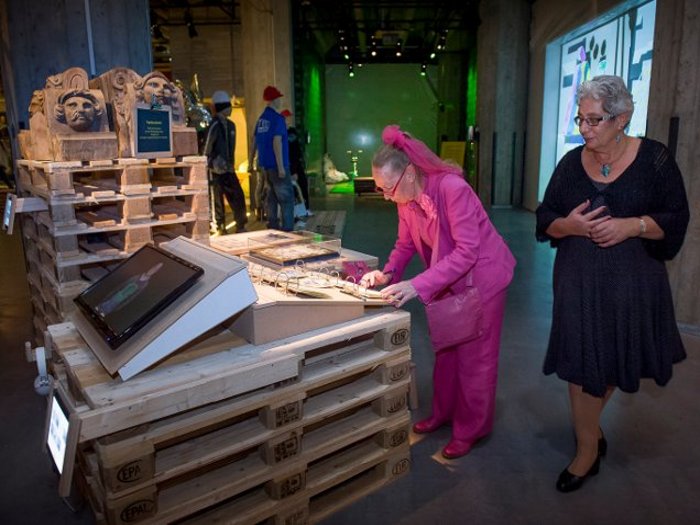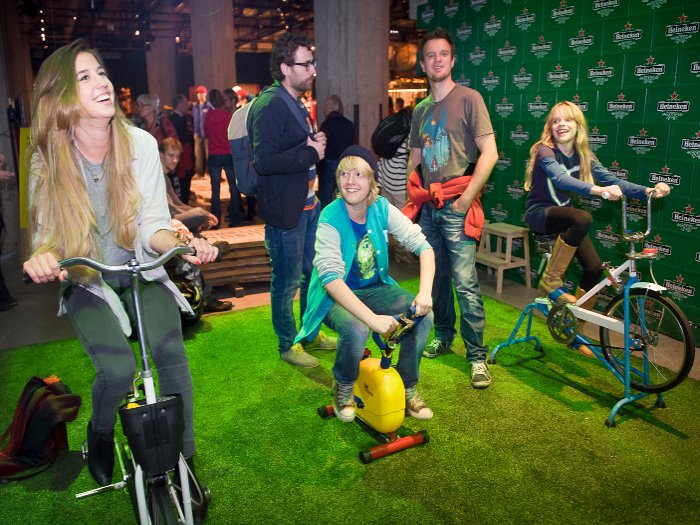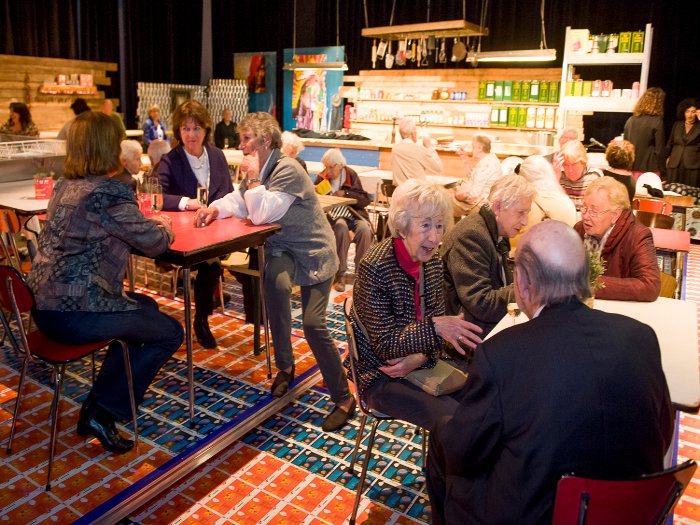Echte Rotterdammers, Rotterdam, by Thomas Ruppert
With crowd-sourced content, an off-site, ‘pop-up’ location and theatrical designer, Rotterdam Museum’s Echte Rotterdammers show ticks all the boxes for community engagement
Client: Museum Rotterdam
Exhibition designer: Thomas Ruppert
Curator and project manager: Nicole van Dijk
Cost: €20,000 for design; €7,500 lighting; €200,000 construction

A spot-lit procession of vividly dressed citizens makes its way across a darkened room, the long skirts and embroidered hats of the early 18th-century progressing through the years to the mini-dressed clubbers of the present day. And with this parade of human diversity, Museum Rotterdam's latest exhibition asserts its primary focus on the people who make the character of this vibrant and ever-changing city. But it also reveals an interesting experiment for large museums in how to find, engage and expand contemporary - and younger - audiences.

Artefacts from aspects of the city's life are displayed on scaffolding
Echte Rotterdammers (Real Rotterdam) is an unusual but compelling temporary exhibition of urban lives and times, staged off-site in the atmospheric location of an old ship repair warehouse in the Dutch city. Using a theatre designer rather than an exhibition designer - Thomas Ruppert, of the city's cutting-edge community theatre company RO Theatre - the sets are all constructed from the paraphernalia of industrial packaging. Each distinctive themed area is built with wooden shipping palettes bolted to metal grids, or in space carved out of stacked cardboard boxes and beer crates. Starkly lit and highly engaging, using first-person narratives and a multimedia mix of artefacts, film, archive and contemporary photography and paintings, it reflects the restless nature of the city and its inhabitants, and reinforces the main themes of the exhibition.
Arranged around the central citizen 'catwalk', the surrounding scaffolding carves out areas that focus on youth sub-culture (Rotterdam has a huge proportion of young residents), dialect (Rotterdammers have their own 'patois' as revealed by the A/V display in a black-box presentation), and work (Rotterdammers apparently believe in hard work, and the various professions that have proliferated here - from shipbuilding to garment making - are demonstrated with an assortment of tools from the past two centuries). Other motifs include sport, faith and 'liveable Rotterdam', the latter exploring the transformation of the city's slums into high-quality social housing, plus the rebuilding of Rotterdam after the Second World War, and the ceaseless reinvention of its landscapes.

Themes of the exhibition, displayed on wooden palettes, include 'liveable Rotterdam'
The exhibition's content and concept were devised after extensive grassroots consultation with some 650 Rotterdam residents, many of whose photographs are plastered up to ceiling height in a 'wall of fame'. Topics were also influenced by opportunities to showcase the existing collection. Says chief curator and project manager Nicole van Dijk: 'Our museum has all the history of the city, but for people just arriving that's not really important. It's not really their history. So we wondered, how can we open up our collection and the history of the city to all the diversity of people in Rotterdam?'
Many heritage museums around the world have been pondering the same question, but few have responded so creatively. However, the 'popup' nature of Echte Rotterdammers is also a pragmatic solution to the museum's current homeless state. Museum Rotterdam recently left its long-term home - an elegant 17th-century mansion in the city centre - because, as van Dijk explains, the building had become a limitation both topically and architecturally: 'We don't really want to be in a 17th-century building any more. That's not a period that plays a big part in the history of Rotterdam.' The Museum hopes to secure premises in one of Dutch architecture superstar Rem Koolhaas's city-centre buildings, opening in 2017.
This temporary location is an inspired choice, in a building formerly owned by the Holland- America shipping line and next to its former offices (now a handsome hotel), which played such a huge part in the lives of so many thousands of hopeful Dutch emigrating to the USA in the 19th and 20th centuries.

The exhibition's innovative content and styling and the museum's social media presence has attracted younger visitors
Rotterdammers have long been a migrant bunch - since the dockyards were established it has been a city that has attracted people willing to work hard - it is still the largest working port in Europe, and one of the busiest, worldwide. But staging an exhibition of this quality in a temporary location had its drawbacks - especially exhibiting artefacts in premises with non-museumquality temperature control, lighting and security. The museum has also had to spend a lot of cash and energy on attracting audiences to this new site - though the payback has been drawing in younger visitors, through its engagement with social media and its edgy location.
Advantages include being able to create a cafe/performance space specifically for events. Every month, RO Theatre stages one of its plays here - Mothers, about the new generations of Rotterdammers being born today; and Homesick, about the life and longings of the newly arrived. The museum is also intensifying community engagement and feedback through a series of dinners and gatherings. Says van Dijk: 'We are looking to engage groups in Rotterdam who have their own vision about Rotterdam identity - hairdressers or taxi drivers or lawyers. We are organising meetings with these people and talking about the objects in the exhibition.'

The theatre/cafe flooring is a vinyl inspired by juice carton packaging from all over the world - in a tribute to Rotterdam's role as Europe's biggest port, as well as its migrant communities
Feedback from staff at the exhibition indicates that a very different audience is indeed being attracted, with one of the most popular features being an array of black and yellow guest lockers, each one featuring a different photograph and short biography of women who helped to make Rotterdam what it is today - drawn from a popular book recently published on the 1,001 women who played a role in Dutch history.
Echte Rotterdammers runs until 16 March, though this site will host another of the museum's exhibitions in October, the topic of which is still under wraps. All van Dijk will say is: 'Next time I want to make it more interactive so that people can co-create with us.' That should be one worth sticking in the diary.
Words by Veronica Simpson
Main suppliers
Lighting:


